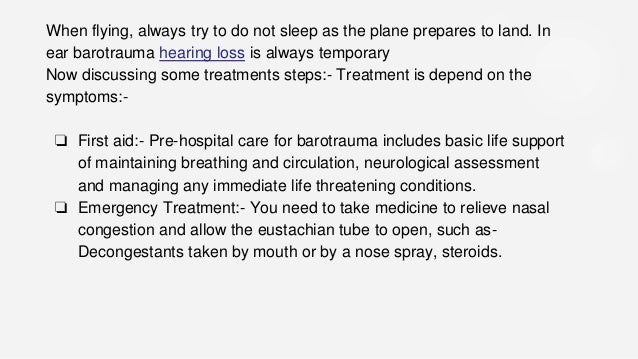

Instruct patients in the use of techniques to equalize pressure in the ears.Hyperbaric staff to examine patient’s ears prior to and following first treatment, then PRN/part-time to decrease possibility of pressure discomfort during treatment.Notify hyperbaric physician if dental pain occurs. Compress slowly, observing patient for signs of tooth pain. If patient has history of dental caries, explain that problems may occur.Screen patient for history of sinus, tooth, and ear problems, especially with situations involving pressure changes.Nursing Interventions Ear, Sinus, Tooth Barotraumas Tilting the head to place the affected ear in an up position may provide added benefit by stretching the involved muscles and Eustachian tube opening.This maneuver is less favorable as it increases intracranial pressure that is transmitted though the inner ear, resulting in round-window rupture Modified Valsalva- performed by forcefully blowing against a closed nose and mouth while maintaining an open glottis.Toynbee maneuver- The patient closes the mouth and nose and swallows.

MEB is usually avoidable with simple preventative measures for pressure equalization and include: This may include drainage of blood through the Eustachian tube into the nasopharynxĪny of the previous findings along with perforation of the tympanic membrane and may involve hemorrhage into the external auditory canal. Hemorrhage into the membrane that appears as darker red patches.įrank hemorrhage into the middle-ear space. This may be particularly noted around the handle of the malleus. Normal tympanic membrane without evidence of injury despite the presence of symptomsĮrythema over part of the tympanic membrane as a result of inflammation. In 1944, Wallace Teed developed a scale for describing the clinical appearance and severity of injury from otic barotrauma.

Otoscopic findings can be seen fairly quickly after the onset of injury and may progress over minutes to hours. As the pressure differential increases, the severity of symptoms increases as well. A sensation of pressure and pain initially develops. Symptoms of middle-ear barotrauma are recognizable. In severe cases, tympanic membrane perforation may occur and is often described as severe pain followed by instant relief upon rupture. If descent is not stopped, and MEB occurs, patients may experience transient conductive hearing loss, vertigo or tinnitus. The most notable initial symptom is middle-ear barotrauma is ear pain during descent. Only properly trained staff working within their scope of practice should evaluate otic barotrauma. The nurse may note signs and symptoms and communicate with the provider who should perform an exam of the tympanic membrane and provide diagnosis, intervention and treatment. Typically, the nurse or physician should evaluate for middle-ear barotrauma.


 0 kommentar(er)
0 kommentar(er)
